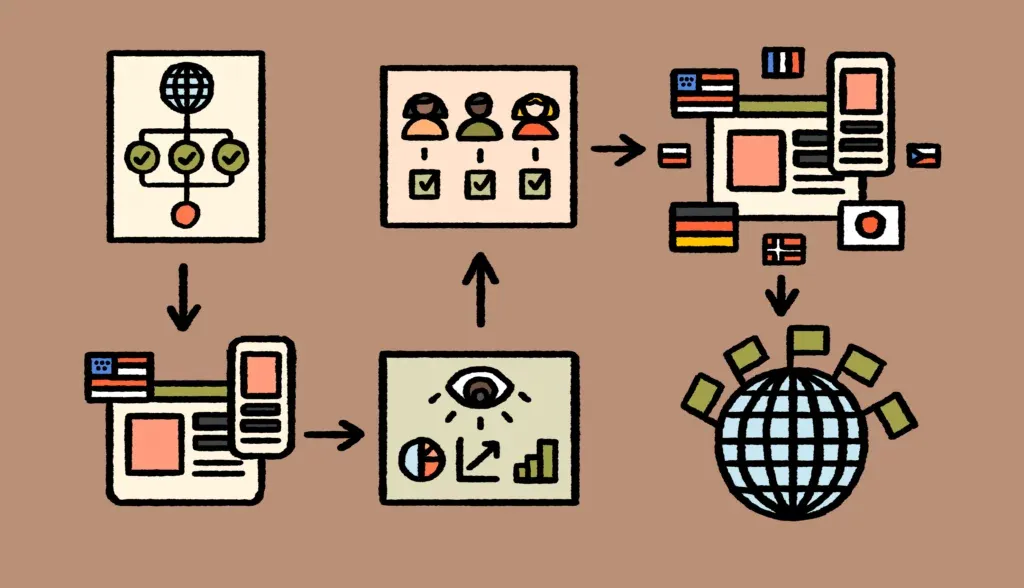Why is brand localization important for global markets?
First let’s close a common misunderstanding about localization: why does a global brand need it? After all, a Coke, Rolex watch, or Apple iPad looks pretty much the same wherever in the world you see it. Aren’t “global” products and services, well, the same everywhere?
Actually they’re not – even a Big Mac is subtly different across the world – but that’s not the whole story. The product or service is part of the brand – but not the whole of it. And how you communicate brand attributes (for example, “motherly love” or “trusted friend”) are culturally distinct in different regions.
That’s why brand localization must start right at the core: your brand values and beliefs. Then it rolls out to your packaging design, slogans and taglines, website, marketing and advertising, your service and support organization. It might sound counterintuitive, but a global brand must feel localized all the way through.
Yes, it’s a big job. But let’s look at the positives: you’ll get:
- A consistent brand image across cultures – even if the words and methods used to build it differ
- Easier management of your brand worldwide, with diverse teams aiming for the same goals
- Firm and documented brand guidelines that can be shared by everyone involved in your localization project
- Shareable assets and images as you build a “library” of visuals and documents ready for use
- Greater cross-cultural relevance, with your brand in one region recognisably related to your brand in another
- Economies of scale, as effort in one place can be rolled out in multiple locations
But how do you actually do it? The watchphrase: cultural awareness. Let’s look at that next.
What things do you need to understand about your market before localizing your brand?
It’s important to approach any new market with an open mind – even if you disagree or dislike some of its cultural nuances. Because whether you like them or not, that’s the market and you’re not going to change them! Here are some things we’ve learned at Lokalise:
- Understand the national character. While stereotypes can be misleading, try to get an idea of what the average citizen behaves and believes – and why. (There are usually reasons.) Reserved yet deeply emotional, like the Japanese? A frontier mentality, like Americans? Seeking delight in everything, like Brazilians? Try to build these personas – or better still, go there yourself.
- How are interpersonal relationships formed? Are there clear hierarchies at work, or is the social structure flat and easygoing? How do people spend their free time? Family focused, or more solo? Knowing how these dynamics work can reveal huge insights when it comes to website content or campaign rollouts.
- How do they communicate? Lots of talking, as in the USA, or more written messages? Group chats and consensus, or defined leaders of each pack? Doing this will help you see how brand attributes pass from one customer to another. (Your greatest brand builders will always be your customers.)
- Who solves their pain you solve now? Few products or services are genuinely unique; you’ll certainly have competitors, and their solution might not look like yours. List them all, see how their brands differ from yours, and plot where your brand might appear in this landscape.
- And always talk to people on the ground! Local experts who live and work in your target market are a great resource – we always recommend engaging with them. They’ll know what works and won’t work, and can save you from missteps.
These factors make a great start to any brand localization strategy. But of course there’ll be problems to overcome. Let’s list a few common ones.
What are some of the challenges of localizing your brand?
Of course, the job doesn’t end at planning; you’ve got to execute your brand localization. Here are some common barriers brands face as they expand to new markets.
- Addressing cultural conflicts. Engaging a new audience may need communicating on channels and media you’re unfamiliar with, like China’s Weibo. Again, local talent can advise.
- The order you do things in. It’s best not to do everything at once. Start small, test and learn, then expand.
- Keeping up with regulations. Different places have different rules on what you can claim about a product and how you can say it – which is why a word-for-word marketing translation rarely works!
- Maintaining brand consistency. As you expand into more markets, there’s a tendency for teams on the ground to go their own way, risking a “fork” in your brand. This can be combated by having clear and accessible guidelines and approval processes.
- Keeping brand promises. If your brand is all about easy shipping, something will have to give when you move into a large market with poor infrastructure. Decide how deeply “Next Day Delivery” really matters to your brand. This is also where advertising localization plays a critical role, your messaging must reflect local realities without compromising the essence of your brand promise.
- Getting hold of accurate information. Reporting and metrics is an important area to cover. What numbers (or other measures) best represent success, and how do you gather the data for them? It’s worth thinking about this early.
Armed with these red flags, let’s take a glimpse at what a successful brand localization strategy looks like.
How do you develop a successful brand localization strategy?
Surprisingly, the next part can be fun. It’s where you work out where you are now – with a list of your brand attributes, non-negotiable assets like colors and logos, and all the “backend” documents that are still part of your brand: your manuals, help resources. Here’s a great way to start:
- First, see the world from your customer persona’s perspective. What does he/she think and feel about your brand today, and how do they react when buying? What are their customer journeys through Sales & Service? What outcomes do they consider successful, and why do they choose your product over a competitors? This should give you a comprehensive list of what you want customers in your new market to think and feel.
- Second, look at how those messages are properly communicated in your new audience’s language. By focusing on the outcomes your words produce – rather than simply translating them – you’re already setting the scene for localization success. It’s why we often call it “transcreation” rather than “translation”. And you’ll find out which messages resonate with everyone … and which have to be tweaked.
- Third, build a list of basic differences between your home market and target. How are dates written, how is currency denominated, what is the form of a standard address? (Remember many countries put the ZIP code before the city.)
- Fourth, look at how the target market’s language affects your web design. Do columns need to be wider, headlines bigger, even whole layouts reconfigured for Asian or Arabic text? This part can be detail-intensive. But it’s essential.
- Finally, draw the roadmap from A (where you are now) to B (the equivalent position in your target market). List the actions, deliverables, and success metrics for each of the above, then work out what resources are needed to reach an MVP (Minimum Viable Product) ready to roll out at small scale. Voila, you’ve got your brand localization plan!
How do you test and launch brand localization efforts?
It’s time now for caution. The best way to test and launch your plan is to start small – so a misstep can be corrected. Few brands roll out perfectly in a new market. Britain’s biggest supermarket chain has tried to move into the USA, and failed, several times; numerous clothing brands, food and drink, and automotive companies have made little headway outside their home market.
So do some research. Hold focus groups, give away products to select testers, arrange seminars where you train people to use your product. You’ll learn more from listening to a roomful of pensioners for an afternoon than a year pondering datasheets. So above all, do your testing in the real world.
What are some examples of successful brand localization?
It’s time for some proof: who’s getting it right? Here’s a list from our Case Studies – we’re proud to say we had a role in their success.
- Neobank Revolut wanted to scale fast and hard – so strived to automate as many processes as possible with the Lokalise platform, enabling them to reach 12m customers in just a few years.
- Orbus Software wanted to improve translation quality – and used Lokalise to streamline and standardize, letting them operate across 48 countries.
- Amsterdam bank Bunq wanted to move fast into Ukraine, and managed a 50,000-word translation project in just a month.
- Music publisher MWM did away with error-prone Google Sheets and switched to Lokalise, providing a consistent platform that lets them launch in new languages 10x faster.
- The healthcare services of Withings grew wings when Lokalise helped them integrate new features in new markets nearly twice as fast as previously.
- The electronics wizards of Arduino maintained their mission to bring easy and simple robotics to the world with Lokalise, ensuring their materials and manuals make sense in schools everywhere.
How do you measure and evaluate brand localization success?
The last part of the puzzle is continuous improvement – gathering data and insights that let you nip, tuck, or completely transform your brand localization strategy based on how well it’s performing. Your success metrics will include sales and profitability, of course – but you’ll also need to know how to attribute the topline to your localization efforts on the ground. To finish up, here are some ideas.
- Compare translation times with Lokalise to time taken before, to judge efficiency
- See how often your asset library is used, to prevent localization efforts forking
- Take polls of how customers feel, telling you if your messages are communicating what you intended
- Compare output with resource usage, to check you’re always doing more with less
- See if best practices are being noted down and followed, to prevent reinventing the wheel
- Compare growth in each market with costs of brand localization, to see where you’re most effective
And many others. But you’ll see the theme here. Brand localization isn’t a one-off project, but an ongoing process – and it’s a key contributor to your success overseas.
Successful brand localization is 360°
In summary: what matters to your brand localization strategy? Everything. The goals, the traits, the words, the images, the colors and fonts – everything.
Fortunately, adopting an end-to-end platform that supports localization can simplify and streamline the whole process, regardless of how many languages and dialects you work with. Because at Lokalise, we understand that going global means being local – and that localizing a brand means a lot more than translating your home page.






